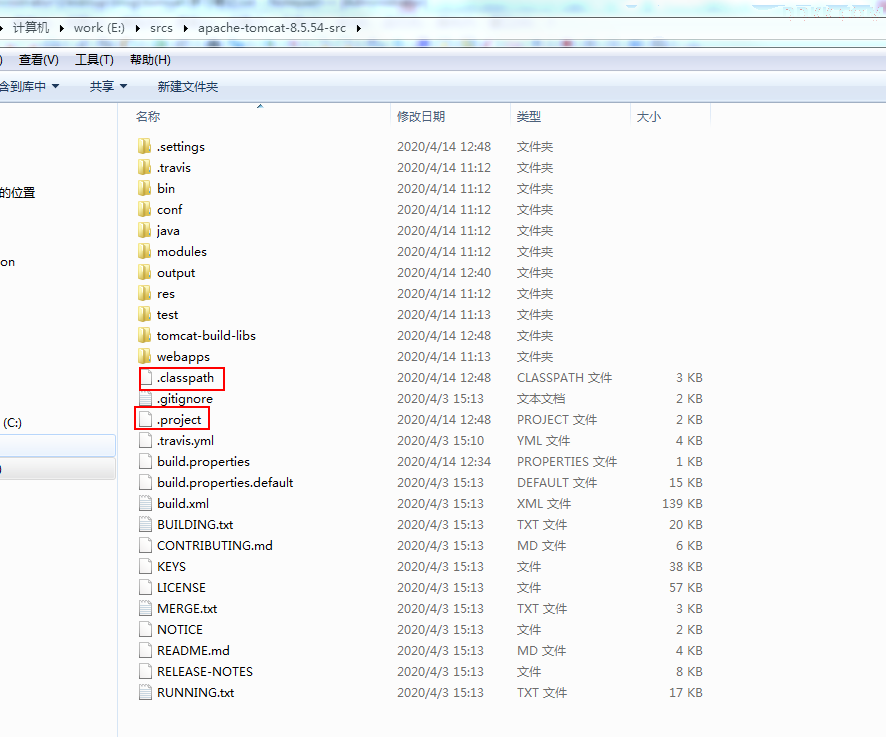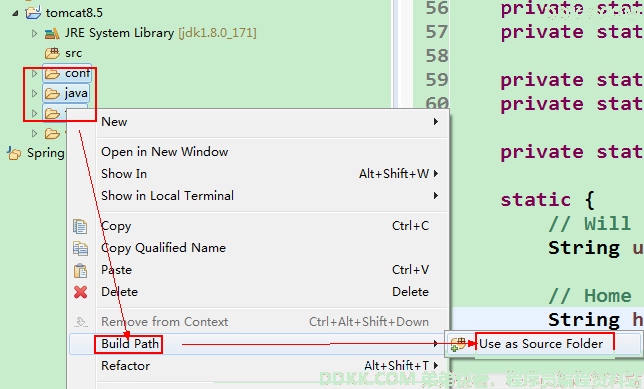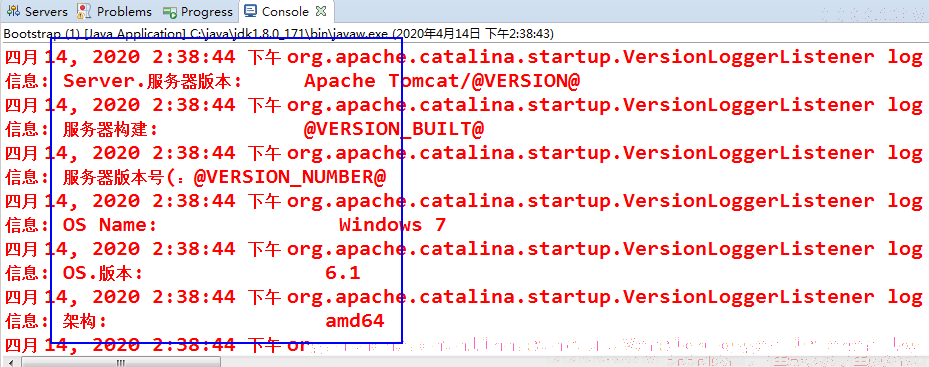01、Tomcat8 源码解析 - 源码环境搭建
为什么要学习Tomcat源码?学习源码的目的是什么?
学习Tomcat源码属于理论学习,实践使用属于技能练习,长时间使用和处理使用问题属于经验积累。
1、 掌握Tomcat原理理论;
可以进行调优:在各种场景下,合理的配置使用Tomcat,最大限度的发挥Tomcat的性能。
可以解决问题:根据原理来解决使用过程中遇到的疑难杂症。
2、 代码学习;
学习大神们如何写简洁、高效、优雅的代码;
学习大神们如何设计代码,比如设计模式;
一、环境信息
TOMCAT版本:apache-tomcat-8.5.54-src.zip
JDK版本:jdk1.8.0_171
ANT版本:apache-ant-1.10.7-bin.zip
IDE:eclipse Oxygen.3a Release (4.7.3a)
操作系统:win7_X64
二、搭建步骤
1、 下载tomcat、jdk、ant、eclipse,官网下载即可(略).;
2、 解压安装配置JDK(略).;
3、 解压eclipse(略).;
4、 安装ant,tomcat默认使用ant构建,有些博客说是tomcat和ant是同一个人开发的有关;
1、解压安装
我的安装目录是:D:\apache-ant-1.10.7
2、配置环境变量
ANT_HOME
D:\apache-ant-1.10.7
path后面追加
;%ANT_HOME%/bin
3、打开CMD验证是否成功
C:\Users\Administrator>ant -version
Apache Ant(TM) version 1.10.7 compiled on September 1 2019
5、 构建tomcat源码;
1、解压tomcat源码
我的解压目录是:E:\srcs\apache-tomcat-8.5.54-src
2、进入解压目录,新建一个build.properties文件和目录tomcat-build-libs,添加如下内容:
# basepath是下载的jar包的路径
base.path=E:/srcs/apache-tomcat-8.5.54-src/tomcat-build-libs
compile.source=1.8
compile.target=1.8
compile.debug=true
3、使用ant下载依赖包
打开cmd,进入E:\srcs\apache-tomcat-8.5.54-src,输入ant,在tomcat-build-libs目录中下载依赖包,最后出现BUILD SUCCSSFUL即可。
E:\srcs\apache-tomcat-8.5.54-src>ant
...
BUILD SUCCESSFUL
Total time: 1 minute 46 seconds
4、转换eclipse工程
(4.1)生成ide-eclipse
E:\srcs\apache-tomcat-8.5.54-src>ant -p
(4.2)源码目录下生成了.classpath 和.project文件
E:\srcs\apache-tomcat-8.5.54-src>ant ide-eclipse

下载所有依赖包:

6、 导入eclipse;
(6.1)方式一:打开eclipse,File->import->General->existing Projects into workspace,找到源码录入,然后finish即可。

(6.2)方式二:方式一导入会引入很多没用的文件,可以换一种方式:
新建java project工程,删掉src目录,然后File->import->General->File System导入如下目录



7、 解决工程报错;
1、添加JUnit4单元测试。
2、添加依赖:
对于方式一 添加ANT_HOME和TOMCAT_LIBS_BASE这两个变量:在.classpath文件里配置了依赖



对于方式二:直接到ant目录和tomcat-build-libs目录拷贝依赖jar包,然后直接build path:

3、 缺少CookieFilter;
/tomcat8.5/test/util/TestCookieFilter.java报错,缺少CookieFilter.java依赖
新建类CookieFilter.java来解决:


/*
* Licensed to the Apache Software Foundation (ASF) under one or more
* contributor license agreements. See the NOTICE file distributed with
* this work for additional information regarding copyright ownership.
* The ASF licenses this file to You under the Apache License, Version 2.0
* (the "License"); you may not use this file except in compliance with
* the License. You may obtain a copy of the License at
*
* http://www.apache.org/licenses/LICENSE-2.0
*
* Unless required by applicable law or agreed to in writing, software
* distributed under the License is distributed on an "AS IS" BASIS,
* WITHOUT WARRANTIES OR CONDITIONS OF ANY KIND, either express or implied.
* See the License for the specific language governing permissions and
* limitations under the License.
*/
package util;
import java.util.Locale;
import java.util.StringTokenizer;
/**
* Processes a cookie header and attempts to obfuscate any cookie values that
* represent session IDs from other web applications. Since session cookie names
* are configurable, as are session ID lengths, this filter is not expected to
* be 100% effective.
*
* It is required that the examples web application is removed in security
* conscious environments as documented in the Security How-To. This filter is
* intended to reduce the impact of failing to follow that advice. A failure by
* this filter to obfuscate a session ID or similar value is not a security
* vulnerability. In such instances the vulnerability is the failure to remove
* the examples web application.
*/
public class CookieFilter {
private static final String OBFUSCATED = "[obfuscated]";
private CookieFilter() {
// Hide default constructor
}
public static String filter(String cookieHeader, String sessionId) {
StringBuilder sb = new StringBuilder(cookieHeader.length());
// Cookie name value pairs are ';' separated.
// Session IDs don't use ; in the value so don't worry about quoted
// values that contain ;
StringTokenizer st = new StringTokenizer(cookieHeader, ";");
boolean first = true;
while (st.hasMoreTokens()) {
if (first) {
first = false;
} else {
sb.append(';');
}
sb.append(filterNameValuePair(st.nextToken(), sessionId));
}
return sb.toString();
}
private static String filterNameValuePair(String input, String sessionId) {
int i = input.indexOf('=');
if (i == -1) {
return input;
}
String name = input.substring(0, i);
String value = input.substring(i + 1, input.length());
return name + "=" + filter(name, value, sessionId);
}
public static String filter(String cookieName, String cookieValue, String sessionId) {
if (cookieName.toLowerCase(Locale.ENGLISH).contains("jsessionid") &&
(sessionId == null || !cookieValue.contains(sessionId))) {
cookieValue = OBFUSCATED;
}
return cookieValue;
}
}
View Code
8、 启动;
java/org/apache/catalina/startup/Bootstrap.java 里面有main函数,启动这个类即可。
问题:控制台打印乱码。

原因:在java中, 读取文件的默认格式是iso8859-1, 而我们中文存储的时候一般是UTF-8. 所以导致读出来的是乱码
解决:修改两个类
1)org.apache.tomcat.util.res.StringManager类中的getString(final String key, final Object... args)方法
public String getString(final String key, final Object... args) {
String value = getString(key);
if (value == null) {
value = key;
}
//解决乱码
try {
value = new String(value.getBytes("ISO-8859-1"), "UTF-8");
}catch(Exception e){
e.printStackTrace();
}
MessageFormat mf = new MessageFormat(value);
mf.setLocale(locale);
return mf.format(args, new StringBuffer(), null).toString();
}
2)org.apache.jasper.compiler.Localizer类的getMessage(String errCode)方法
public static String getMessage(String errCode) {
String errMsg = errCode;
try {
if (bundle != null) {
errMsg = bundle.getString(errCode);
}
} catch (MissingResourceException e) {
}
//解决乱码
try {
errMsg = new String(errMsg.getBytes("ISO-8859-1"), "UTF-8");
}catch(Exception e){
e.printStackTrace();
}
return errMsg;
}
改完重启:
